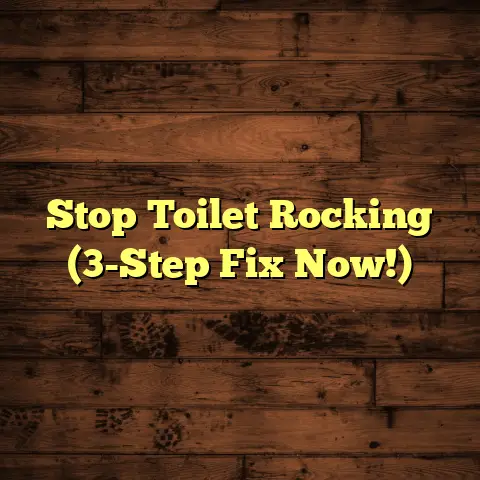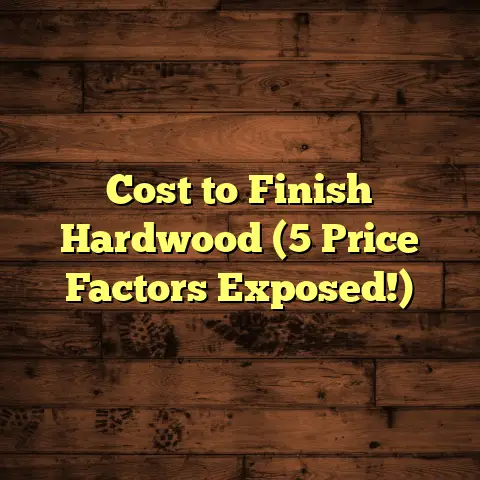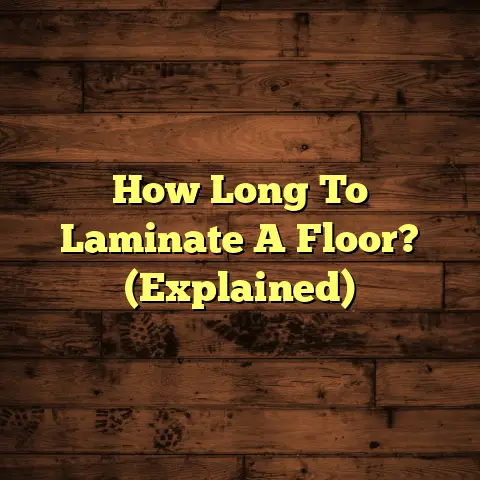Engineered Wood: Underlayment Needed? (1 Mistake!)
Right now, everyone’s obsessed with beautiful floors, right?
Especially engineered wood.
It’s popping up everywhere – from sleek, modern apartments to cozy, traditional homes.
Why?
Because it looks fantastic, it’s pretty tough, and it’s a bit more eco-friendly than some other options.
Plus, it handles humidity better than solid hardwood, which is a huge win for many of us.
But here’s the thing: even with a great material like engineered wood, there’s one HUGE mistake I see homeowners make all the time.
And it can lead to some serious headaches down the road.
Curious? Let’s dive in!
Section 1: Understanding Engineered Wood Flooring
Okay, first things first: what is engineered wood flooring, exactly?
Simply put, it’s not solid wood all the way through.
Instead, it’s made up of layers.
Think of it like a multi-layered cake.
The top layer, the one you see and walk on, is a veneer of real hardwood.
This is what gives you that beautiful wood look and feel.
Underneath that, you’ll find multiple layers of plywood or high-density fiberboard (HDF).
These layers are bonded together to create a super stable core.
This construction is key because it makes engineered wood less susceptible to warping and expanding due to changes in humidity and temperature.
Solid hardwood, on the other hand, is more prone to these issues.
The manufacturing process is pretty cool.
These layers are glued together under high pressure and heat, with the grain of each layer running in different directions.
This cross-layer construction is what gives engineered wood its strength and stability.
And the finishes?
Oh man, the options are endless!
You can find engineered wood in pretty much any wood species you can imagine – oak, maple, hickory, walnut – you name it.
Plus, you can get it in different widths, lengths, and finishes.
From smooth and glossy to hand-scraped and matte, there’s an engineered wood floor to match any design style.
Section 2: The Role of Underlayment in Flooring
Now, let’s talk about underlayment. What is it, and why should you care?
Underlayment is a layer of material that goes between your subfloor (the structural floor underneath) and your finished flooring.
Think of it as a cushion or a buffer.
Traditionally, underlayment has been used for a few key reasons:
- Sound Insulation: It helps to dampen noise and reduce sound transmission between floors.
- Moisture Control: It can act as a barrier against moisture that might be coming up from the subfloor.
- Cushioning: It provides a bit of extra cushioning underfoot, making the floor more comfortable to walk on.
- Leveling: It can help to smooth out minor imperfections in the subfloor.
There are several different types of underlayment available, each with its own set of benefits:
- Foam Underlayment: This is a common and affordable option that provides good cushioning and sound insulation.
- Cork Underlayment: Cork is a natural and sustainable material that offers excellent sound and thermal insulation.
- Rubber Underlayment: Rubber is a dense and durable option that’s great for soundproofing and impact resistance.
- Felt Underlayment: This type is often made from recycled materials and provides good cushioning and sound absorption.
If you live in a multi-story home, underlayment is especially important.
It can make a HUGE difference in how much noise travels between floors.
Trust me, your downstairs neighbors will thank you!
I have seen this first hand when working with apartments and townhouses.
Section 3: Do You Need Underlayment with Engineered Wood?
Okay, here’s the million-dollar question: do you really need underlayment with engineered wood flooring?
This is a hot topic in the flooring world, and you’ll find plenty of opinions on both sides.
Arguments for using underlayment:
- Moisture Protection: Even though engineered wood is more moisture-resistant than solid hardwood, it’s not waterproof.
Underlayment can provide an extra layer of protection against moisture that could damage your floors. - Sound Reduction: If you want to minimize noise, underlayment is a must.
It can significantly reduce sound transmission, especially in homes with hard surfaces. - Comfort: Underlayment adds a bit of cushioning underfoot, making your floors more comfortable to walk on.
- Warranty Requirements: Some engineered wood manufacturers require the use of underlayment to maintain the warranty.
Always check the manufacturer’s specifications before you install your floors.
Arguments against using underlayment:
- Cost: Underlayment adds to the overall cost of the flooring project.
- Installation Time: It takes extra time and effort to install underlayment.
- Not Always Necessary: In some cases, if your subfloor is perfectly level and dry, and you’re not concerned about noise, you might be able to get away without underlayment.
So, when might underlayment be beneficial?
- Over Concrete Slabs: Concrete can be a major source of moisture, so underlayment is essential to protect your engineered wood floors.
- In Basements: Basements are often damp, so underlayment is a must.
- In Humid Climates: If you live in a humid area, underlayment can help to prevent moisture damage.
- In Multi-Story Homes: Underlayment can significantly reduce noise transmission between floors.
Here’s a little table to help you visualize it:
Section 4: The One Common Mistake Homeowners Make
Alright, let’s get to the heart of the matter.
The single biggest mistake I see homeowners make when installing engineered wood flooring is…
…skipping underlayment altogether!
I know, I know, it can be tempting to cut corners and save a few bucks.
But trust me, this is one area where you don’t want to skimp.
I’ve seen countless cases where homeowners have regretted not using underlayment.
I remember one client, Sarah, who installed beautiful engineered wood floors in her basement without underlayment.
A few months later, she started noticing a musty smell and some cupping in the planks.
Turns out, moisture was seeping up from the concrete slab, and the floors were starting to warp.
She ended up having to replace the entire floor, which cost her a LOT more than the underlayment would have!
Proper preparation is key to a successful flooring installation.
Skipping underlayment can have some serious long-term consequences, including:
- Moisture Damage: As we saw with Sarah, moisture can wreak havoc on engineered wood floors.
- Sound Issues: Without underlayment, you’ll hear every footstep and every creak.
- Uneven Flooring: If your subfloor isn’t perfectly level, the engineered wood can flex and move, leading to an uneven surface.
- Voided Warranty: As I mentioned earlier, some manufacturers require underlayment to maintain the warranty.
Section 5: Analyzing the Impact of Skipping Underlayment
Let’s dig a little deeper into the specific problems that can arise from not using underlayment:
- Increased Noise Transmission: Without underlayment, sound waves can travel easily through the floor and into the rooms below.
This can be a major issue in apartments, condos, and multi-story homes.
According to the National Research Council Canada, underlayment can reduce impact noise by as much as 20 decibels.
1 - Reduced Comfort Underfoot: Engineered wood is already a fairly hard surface.
Without underlayment, it can feel even harder and less comfortable to walk on.
This can be especially noticeable if you’re standing for long periods of time. - Potential for Moisture-Related Issues: Moisture is the enemy of wood flooring.
Without underlayment, moisture can seep up from the subfloor and damage the engineered wood, causing it to warp, cup, or even rot. - Longevity and Performance: All of these problems can ultimately affect the longevity and performance of your engineered wood flooring.
You might find yourself having to replace the floors much sooner than you would have if you had used underlayment.
Here is a quote from the World Floor Covering Association (WFCA) that I always share with my clients: “The use of a proper underlayment can extend the life of your floor covering and improve its overall performance.”
Section 6: Conclusion: Making an Informed Decision
So, what’s the bottom line? Do you need underlayment with engineered wood flooring?
In most cases, the answer is a resounding YES.
While there might be some rare situations where you can get away without it, the benefits of underlayment far outweigh the costs.
Underlayment can protect your floors from moisture, reduce noise, add comfort, and even extend the life of your flooring investment.
I always encourage my clients to weigh the pros and cons carefully and to consult with a flooring professional before making a decision.
I always say, “It’s better to be safe than sorry!”
Choosing the right flooring can be tough, but it’s also an exciting opportunity to transform your home.
By understanding your options and making informed decisions, you can create a space that’s both beautiful and functional.
Remember, your floors are a long-term investment.
Taking the time to do it right will pay off in the long run.
Happy flooring!





